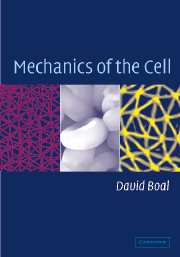Book contents
- Frontmatter
- Contents
- Preface
- List of symbols
- Chapter 1 Introduction to the cell
- Part I Rods and ropes
- Chapter 2 Polymers
- Chapter 3 Two-dimensional networks
- Chapter 4 Three-dimensional networks
- Part II Membranes
- Part III The whole cell
- Appendix A Animal cells and tissues
- Appendix B The cell's molecular building blocks
- Appendix C Elementary statistical mechanics
- Appendix D Elasticity
- Glossary
- References
- Index
Chapter 4 - Three-dimensional networks
Published online by Cambridge University Press: 05 June 2012
- Frontmatter
- Contents
- Preface
- List of symbols
- Chapter 1 Introduction to the cell
- Part I Rods and ropes
- Chapter 2 Polymers
- Chapter 3 Two-dimensional networks
- Chapter 4 Three-dimensional networks
- Part II Membranes
- Part III The whole cell
- Appendix A Animal cells and tissues
- Appendix B The cell's molecular building blocks
- Appendix C Elementary statistical mechanics
- Appendix D Elasticity
- Glossary
- References
- Index
Summary
The filaments of the cell vary tremendously in their bending resistance, having a visual appearance ranging from ropes to threads if viewed in isolation on the length scale of a micron. Collections of these biological filaments have strikingly different structures: a bundle of stiff microtubules may display strong internal alignment, whereas a network of very flexible proteins may resemble the proverbial can of worms. Thus, the elastic behavior of multicomponent networks containing both stiff and floppy filaments may include contributions from the energy and the entropy of their constituents. In this chapter, we first review a selection of three-dimensional networks from the cell, and then establish the elastic properties of four different model systems, ranging from entropic springs to rattling rods. In the concluding section, these models are used to interpret, where possible, the measured characteristics of cellular networks.
Networks of biological rods and ropes
The filaments of the cytoskeleton and extracellular matrix collectively form a variety of chemically homogeneous and heterogeneous structures. Let's begin our discussion of these structures by describing two networks of microtubules found in the cell. The persistence length of microtubules is of the order of millimeters, such that microtubules bend only gently on the scale of microns and will not form contorted networks (see Section 2.5). For example, the microtubules of the schematic cell in Fig. 4.1(a) are not cross-linked, but rather extend like spikes towards the cell boundary, growing and shrinking with time.
Information
- Type
- Chapter
- Information
- Mechanics of the Cell , pp. 97 - 134Publisher: Cambridge University PressPrint publication year: 2001
